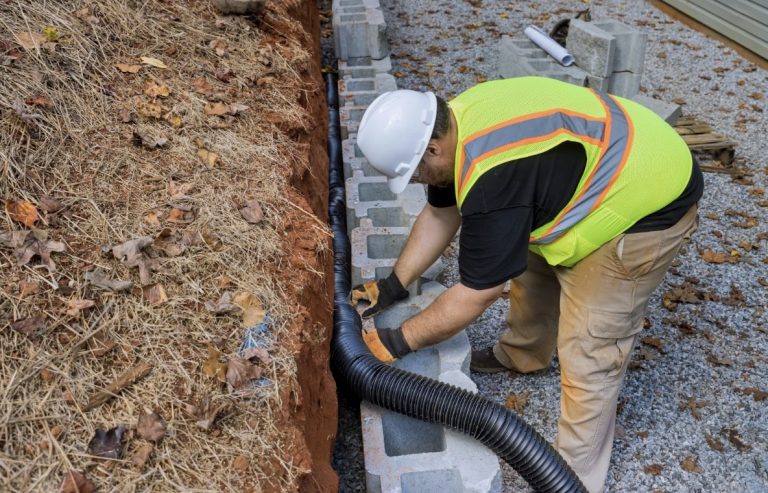Good drainage is crucial for keeping your home safe and dry. When water doesn’t flow properly away from your house, it can lead to a host of problems, including foundation damage, mold growth, and flooding. If you’re experiencing drainage issues, it’s important to address them quickly and effectively. Here are some best practices for effective drainage repair to help you fix the flow and protect your home.
1. Identify the Problem
The first step in any drainage repair is to identify the source of the problem. Common drainage issues include:
- Clogged Drains: Debris, leaves, and dirt can block your drains, preventing water from flowing away properly.
- Improper Slope: If the ground around your home doesn’t slope away from the foundation, water can pool and cause damage.
- Broken or Cracked Pipes: Over time, drainage pipes can crack or break, leading to leaks and water buildup.
- Gutter Issues: If your gutters are clogged or not properly aligned, they can’t direct water away from your home effectively.
Inspect your property to determine where the water is pooling and what might be causing the issue. This will help you choose the right repair method.
2. Clear Blocked Drains
If your drains are clogged, clearing them is the first step to restoring proper flow. Here’s how you can do it:
- Remove Debris: Start by removing any visible debris from the drain grates and gutters. You can use a garden hose to flush out smaller debris.
- Use a Drain Snake: For more stubborn clogs, a drain snake can help. Insert the snake into the drain and twist it to break up and remove the blockage.
- Try a Drain Cleaner: If the clog persists, you can use a chemical drain cleaner. Be sure to follow the instructions carefully and use a cleaner that’s safe for your type of pipes.
Clearing the drains regularly can prevent future blockages and keep the water flowing smoothly.
3. Correct the Slope
If water is pooling near your home’s foundation, the slope of your yard might be to blame. The ground around your house should slope away from the foundation by about 6 inches over 10 feet. Here’s how to correct the slope:
- Add Soil: If the ground is flat or slopes towards your home, add soil to create a gentle slope away from the foundation. Be sure to pack the soil tightly to prevent it from washing away.
- Install a French Drain: A French drain is a gravel-filled trench with a perforated pipe that directs water away from your home. It’s a great solution for areas with persistent drainage problems.
- Regrade the Yard: For more severe slope issues, you may need to regrade the entire yard. This involves reshaping the ground to ensure proper drainage. It’s a more intensive solution but very effective for serious drainage problems.
Correcting the slope will help ensure that water flows away from your home, reducing the risk of foundation damage.
4. Repair or Replace Damaged Pipes
Broken or cracked drainage pipes can lead to leaks and poor drainage. If you suspect a problem with your pipes, you’ll need to repair or replace them:
- Locate the Damage: Use a video camera inspection to locate the damage within the pipe. This will help you determine whether a repair or replacement is needed.
- Patch Small Cracks: For small cracks or holes, you can use a patch kit to seal the damage. These kits are available at most hardware stores and are easy to use.
- Replace Severely Damaged Pipes: If the damage is extensive, it’s best to replace the affected section of the pipe. PVC pipes are a durable and cost-effective option for drainage systems.
Ensuring that your pipes are in good condition is key to maintaining effective drainage.
5. Maintain Your Gutters
Gutters play a crucial role in directing water away from your home’s foundation. To keep them working properly:
- Clean Gutters Regularly: Remove leaves, twigs, and other debris from your gutters at least twice a year. You can use a gutter scoop or a garden hose to clear them out.
- Check for Leaks: Inspect your gutters for leaks or cracks. Use a gutter sealant to repair any small leaks and prevent water from dripping near your foundation.
- Ensure Proper Alignment: Make sure your gutters are properly aligned and sloped so that water flows towards the downspouts. If needed, adjust the hangers to correct the slope.
Well-maintained gutters are essential for preventing water damage and ensuring effective drainage.
6. Consider Installing a Sump Pump
If you live in an area with heavy rainfall or a high water table, a sump pump can be a valuable addition to your drainage system. A sump pump is installed in a pit in your basement or crawl space and automatically pumps water out and away from your home when the water level rises:
- Install the Pump in a Sump Pit: The pump should be installed in a pit that’s deep enough to collect water from the surrounding area.
- Ensure Proper Drainage: The pump should discharge the water far enough away from your home to prevent it from flowing back towards the foundation.
- Test the Pump Regularly: Test your sump pump periodically to ensure it’s working correctly, especially before the rainy season.
A sump pump can provide an extra layer of protection against flooding and water damage.
Conclusion
Effective drainage is essential for protecting your home from water damage. By identifying the source of drainage problems and following best practices for repair, you can ensure that water flows away from your home as it should. Whether it’s clearing blocked drains, correcting the slope of your yard, or maintaining your gutters, taking the time to address drainage issues will keep your home safe, dry, and free from water-related damage.


0 Comments